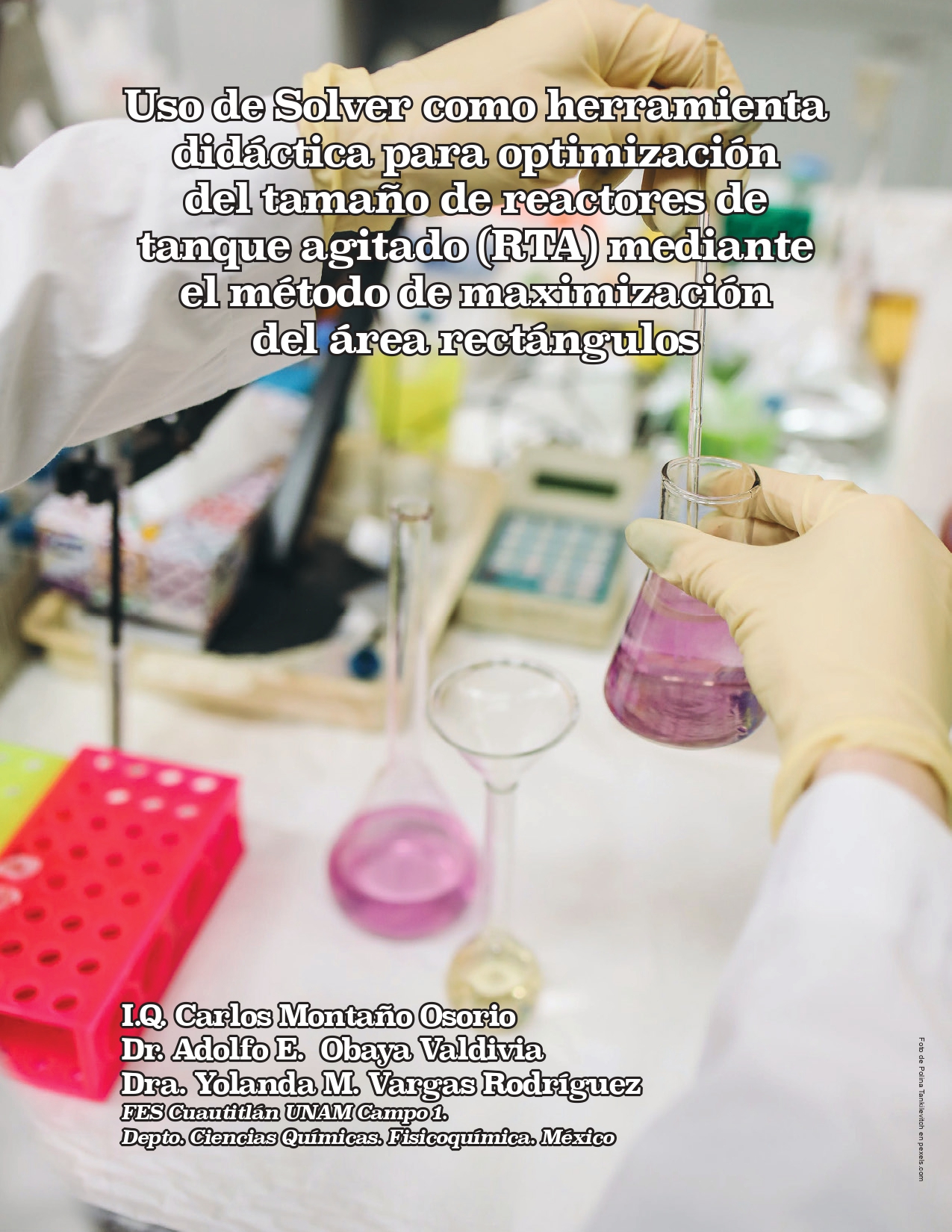Uso de Solver como herramienta didáctica para optimización del tamaño de reactores de tanque agitado (RTA) mediante el método de maximización del área rectángulos
Palabras clave:
Chemical Kinetics, Serial CSTR Reactors, Rectangle Method
Resumen
The objective of this work is to achieve significant learning and its better understanding by students who are studying Chemical Kinetics and Reactor Design Principles. Using the Excel solver as a didactic tool, it presents the analytical solution to the system of equations generated to determine the optimal size of CSTR reactors that operate in series in an isothermal and isobaric way. The procedure involves knowing the intermediate conversion achieved by each reactor to determine the optimal volume of each unit, which is described by the method of maximizing the area of rectangles on the Levenspiel curve, which is extrapolabled “n” reactor units, unlike the graphical method that is iterative and only practical up to three units.
Descargas
La descarga de datos todavía no está disponible.
Citas
[1] Castellan, W. G. (1998) Fisicoquímica, Adisson-Weslley Iberoamérica, 2 Ed. USA.
[2] Chorkendorff, I.; Niemantsverdried, J. W. (2007) Concepts of modern catalysis and kinetic. 2nd ed. Wiley VCH. Alemania.
[3] Dashi, A., Khorsand, K., Marvast, M. A. & Kakavand, M. (2006). Modeling and simulation of ammonio synthesis reactor. Petrol. Coal. 48 (2) 15-23.
[4] Elizadle, I., Ramírez, R. & Ancheyta, J. (2013). Analytical solution to obtain the optimal volumen of a series of continuous tank reactors sustaining a first order reaction. Avances en ciencias e Ingeniería. 4 (2) 51-60.
[5] Espenson, J. H. (1995) Chemical kinetics and reaction mechanisms, McGraw-Hill, 2 ed. México.
[6] Fogler, S. H. (2010) Essentials of chemical reaction engineering, Pearson Prentice Hall, 5 ed. USA.
[7] Froment. G. F. & Kenneth, B. B. (2010) Chemical reactor analysis and design, John Wiley & Sons, 3 ed. USA.
[8] Green, D. W.; Southard, M. Z. (2019) Perry’s Chemical Engineers’ Handbook, 9th Edition. McGraw-Hill Education.
[9] Hong, R., Li, X., Li, H. & Yuan, W. (1997) Modeling and simulation of SO2 oxidation in a fixed reactor with periodic Flow reversal. Catal. Today. 38, 47-58.
[9] Levenspiel, O. (2010) Ingeniería de las reacciones químicas, Limusa Wiley, 3 ed. México.
[10] Szépe, S., Levenspiel, O. (1967) Optimal temperatura pólices for reactors subjet to catalyst deactivation-I Batch Reactor. Chem. Eng. Sci. 23, 881-894.
[2] Chorkendorff, I.; Niemantsverdried, J. W. (2007) Concepts of modern catalysis and kinetic. 2nd ed. Wiley VCH. Alemania.
[3] Dashi, A., Khorsand, K., Marvast, M. A. & Kakavand, M. (2006). Modeling and simulation of ammonio synthesis reactor. Petrol. Coal. 48 (2) 15-23.
[4] Elizadle, I., Ramírez, R. & Ancheyta, J. (2013). Analytical solution to obtain the optimal volumen of a series of continuous tank reactors sustaining a first order reaction. Avances en ciencias e Ingeniería. 4 (2) 51-60.
[5] Espenson, J. H. (1995) Chemical kinetics and reaction mechanisms, McGraw-Hill, 2 ed. México.
[6] Fogler, S. H. (2010) Essentials of chemical reaction engineering, Pearson Prentice Hall, 5 ed. USA.
[7] Froment. G. F. & Kenneth, B. B. (2010) Chemical reactor analysis and design, John Wiley & Sons, 3 ed. USA.
[8] Green, D. W.; Southard, M. Z. (2019) Perry’s Chemical Engineers’ Handbook, 9th Edition. McGraw-Hill Education.
[9] Hong, R., Li, X., Li, H. & Yuan, W. (1997) Modeling and simulation of SO2 oxidation in a fixed reactor with periodic Flow reversal. Catal. Today. 38, 47-58.
[9] Levenspiel, O. (2010) Ingeniería de las reacciones químicas, Limusa Wiley, 3 ed. México.
[10] Szépe, S., Levenspiel, O. (1967) Optimal temperatura pólices for reactors subjet to catalyst deactivation-I Batch Reactor. Chem. Eng. Sci. 23, 881-894.

Publicado
2023-12-20
Cómo citar
Montaño Osorio, C., Obaya Valdivia, A. E., & Vargas Rodríguez, Y. M. (2023). Uso de Solver como herramienta didáctica para optimización del tamaño de reactores de tanque agitado (RTA) mediante el método de maximización del área rectángulos. Contactos, Revista De Educación En Ciencias E Ingeniería, (131), 49-59. Recuperado a partir de https://contactos.izt.uam.mx/index.php/contactos/article/view/315
Sección
Artículos





